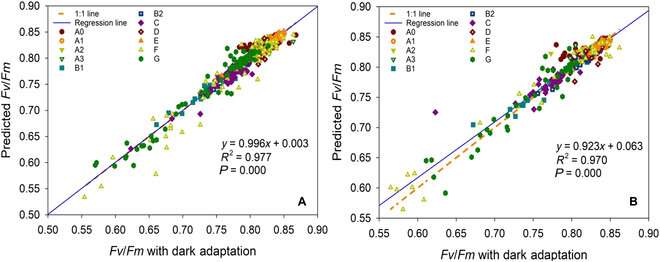This article has been reviewed according to Science X's editorial process and policies. Editors have highlighted the following attributes while ensuring the content's credibility:
fact-checked
trusted source
proofread
An artificial intelligence method for rapid plant phenotyping under complex conditions

During photosynthesis, the green pigment chlorophyll in algae and plants absorbs most of the energy from incoming light. Chlorophyll gets excited and transfers this energy to the energy-harvesting protein complexes photosystem I (PSI) and II (PSII). However, some of this energy dissipates as heat or chlorophyll a fluorescence (ChlF).
Changes in the environment or plant physiology that affect PSII also alter ChlF, which can therefore be used as a fast, sensitive, and non-destructive indicator of PSII status. Indeed, ChlF is a powerful tool for assessing multiple aspects of photosynthesis. Though ChlF measurements and analyses are complex, they allow researchers to study the effects of various types of stressors on photosynthesis. For example, ChlF is used to monitor the effects of drought, heat, pollution, and nutrition status.
A very important measurement that can be obtained from ChlF is the ratio of variable to maximum fluorescence, or Fv/Fm. This ratio provides information on carbon metabolism and is a reliable indicator of photosynthesis. However, plant samples must first be dark-adapted in order to quantify Fv/Fm.
Dark adaptation is tedious and time-consuming, so avoiding it can speed up both the experiments and analyses. Now, researchers from Jiangnan University, the University of Columbia, and the University of Illinois-Urbana Champaign, have developed a rapid method for accurate Fv/Fm analyses using artificial intelligence (AI), without the need for dark adaptation.
Their findings were published in Plant Phenomics.
"AI let us reveal the hidden relationship between Fv/Fm and ChlF without dark adaptation. We have achieved significant time-saving and can now deliver quick insights into plant phenomics," says Dr. Ya Guo, the study's lead investigator based at the Key Laboratory of Advanced Process Control for Light Industry, Jiangnan University.
The AI method, known as least-squares support vector machine model (LSSVM), bypasses the need for dark adaptation by mathematically predicting Fv/Fm ratios under dark adaptation from ChlF measurements. This analytical process is more economical and less tedious, as no dark adaptation equipment is actually needed.
Their experiments in this study involved over 7,000 samples of 6 different genetic varieties of plants. These plants were subjected to 4 types of drought conditions, several different environmental temperatures, 3 different growing seasons (spring, summer, and winter), a wide range of photosynthetic photon flux densities, and 3 different growing locations (field, greenhouse, and laboratory). All of these conditions resulted in enormous differences in ChlF values.
These findings show that the LSSVM model can predict Fv/Fm ratios in plant samples exposed to a wide range of conditions, with very small errors. In other words, this model can reliably identify the hidden relationship between ChlF and Fv/Fm values without dark adaptation.
When elaborating on the advantages of their AI-based method, Dr. Guo explains, "The LSSVM model showed excellent performance in determining Fv/Fm from ChlF without dark adaptation and processed each sample in under four milliseconds. Its prediction results had high correlation coefficients, low root mean square errors, and acceptable residual prediction deviation. These are three key performance metrics that confirmed its accuracy."
ChlF is a very useful tool for plant phenotyping. Understanding the mechanisms underlying plant phenotypes is critical for improving crop growth and yield. So far, dark adaptation has been necessary for making ChlF measurements. However, different dark adaptation times have been shown to affect ChlF results. Dark adaptation also needs additional equipment and is time-consuming.
In this study, Dr. Guo and his colleagues have set a new benchmark by measuring ChlF without dark adaptation to obtain true values for Fv/Fm ratios. Their new LSSVM model lets them conveniently probe plant phenotype and physiological status by leveraging the speed and accuracy of AI. Most importantly, measurements can now be done directly in the field, under complex environmental conditions, and in real-time.
"This study shows us that AI can uncover the hidden behavior of biological processes like photosynthesis with few errors. Our proof of concept could soon be used to predict other ChlF parameters like the photochemical quantum yield of PSII and the quantum yield of energy dissipation. We've only just scratched the surface of its application," concludes Dr. Guo.
More information: Qian Xia et al, Determination of F v / F m from Chlorophyll a Fluorescence without Dark Adaptation by an LSSVM Model, Plant Phenomics (2023). DOI: 10.34133/plantphenomics.0034
Provided by NanJing Agricultural University




















